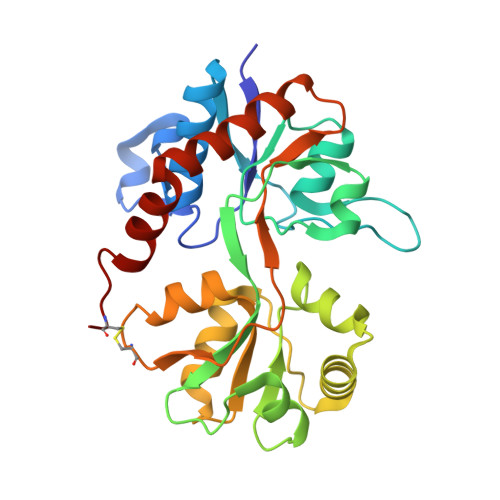Tyr702 Is an Important Determinant of Agonist Binding and Domain Closure of the Ligand-Binding Core of GluR2.
Frandsen, A., Pickering, D.S., Vestergaard, B., Kasper, C., Nielsen, B.B., Greenwood, J.R., Campiani, G., Fattorusso, C., Gajhede, M., Schousboe, A., Kastrup, J.S.(2005) Mol Pharmacol 67: 703-713
- PubMed: 15591246
- DOI: https://doi.org/10.1124/mol.104.002931
- Primary Citation of Related Structures:
1SYH, 1SYI, 1XHY - PubMed Abstract:
Ionotropic glutamate receptors mediate most rapid excitatory synaptic transmission in the mammalian central nervous system, and their involvement in neurological diseases has stimulated widespread interest in their structure and function. Despite a large number of agonists developed so far, few display selectivity among (S)-2-amino-3-(3-hydroxy-5-methylisoxazol-4-yl) propionic acid (AMPA)-receptor subtypes. The present study provides X-ray structures of the glutamate receptor 2 (GluR2)-selective partial agonist (S)-2-amino-3-(1,3,5,6,7-pentahydro-2,4-dioxocyclopenta[e] pyrimidin-1-yl) propanoic acid [(S)-CPW399] in complex with the ligand-binding core of GluR2 (GluR2-S1S2J) and with a (Y702F)GluR2-S1S2J mutant. In addition, the structure of the nonselective partial agonist kainate in complex with (Y702F)GluR2-S1S2J was determined. The results show that the selectivity of (S)-CPW399 toward full-length GluR2 relative to GluR3 is reflected in the binding data on the two soluble constructs, allowing the use of (Y702F)GluR2-S1S2J as a model system for studying GluR2/GluR3 selectivity. Structural comparisons suggest that selectivity arises from disruption of a water-mediated network between ligand and receptor. A D1-D2 domain closure occurs upon agonist binding. (S)-CPW399 and kainate induce greater domain closure in the Y702F mutant, indicating that these partial agonists here act in a manner more reminiscent of full agonists. Both kainate and (S)-CPW399 exhibited higher efficacy at (Y702F)GluR2(Q)i than at wild-type GluR2(Q)i. Whereas an excellent correlation exists between domain closure and efficacy of a range of agonists at full-length GluR2 determined by electrophysiology in Xenopus laevis oocytes, a direct correlation between agonist induced domain closure of (Y702F)GluR2-S1S2J and efficacy at the GluR3 receptor is not observed. Although it clearly controls selectivity, mutation of this residue alone is insufficient to explain agonist-induced conformational rearrangements occurring in this variant.
Organizational Affiliation:
Biostructural Research, Department of Medicinal Chemistry, Danish University of Pharmaceutical Sciences, Universitetsparken 2, DK-2100, Copenhagen Ø, Denmark.
















